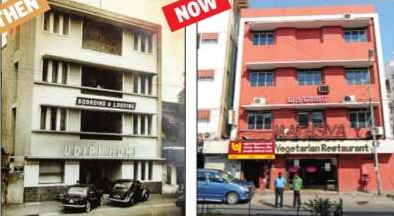When Ramana Bhat, a vedic scholar from Udupi, wanted to migrate to the Madras Presidency along with his six children in the early 1900s after a severe drought hit Dakshina Kannada region, Egmore was his immediate choice. Egmore, derived from Elambore, which means seven villages in Tamil, was mostly filled with government employees from the brahmin community. They lived in single storey houses hidden amidst thick vegetation, and worked in government offices lodged in majestic Indo-Saracenic buildings.
Bhat’s was one of the first seven families that shifted base to Madras. Having witnessed the migration of many families driven out of their soil by drought over the next few months, Bhat’s household wanted to serve their community in some way. This is when their experience in the temples and its kitchens in Udupi came in handy.
Two of Bhat’s sons Shyam Bhat and Hari Bhat started Udupi Sri Krishna Bhavan, one of the earliest vegetarian hotels, on Hall’s Road, Egmore. Over the years, it grew to be a popular landmark in the area and was rechristened as Udipi Home.
“In 1955, we were the first to have an air-conditioner in a standalone restaurant in the city,” said 46-year-old Ram Bhat, son of Hari Bhat, who now runs Udupi Home, which now includes lodging and a restaurant named Mathsya. Bhat said although there was a sizeable north Indian population in the area, there was no restaurant catering to them. “We were among the first to introduce north Indian cuisine in our menu,” he said. Cold drinking water, a luxury in the 60s and 70s, was sold for five paise.
The restaurant boasts of several celebrities who were regulars before they went on to become big names. The Amritraj brothers boosted their energy with a generous glass of badam kheer every day after tennis practice in the 1970s at the stadium nearby, which is now the Mayor Radhakrishnan stadium. MG Ramachandran too was a fan of the kheer.
“Actors Nasser, ‘Thalaivasal’ Vijay and director Selva worked at our restaurant as stewards,” Bhat recalled. But the owners of the more than a century-old hotel, valued some of their little known customers, who had been their regulars for many years and wanted to honour them. Hence came ‘P J Uthappam’, named after a Prashanth Jain, and ‘Pistah milkshake Pal’s Special’ after a Palaniappan. Both had been customers for four decades. Egmore was, however, more than just the food empire built by the Bhat family. With public halls built during the British Era for entertainment, Egmore has always been a self-contained locality.
The Egmore station had a special feature. Cars could go up to the platform so that passengers could get off and board the trains from there, said Ram Bhat.
“The Egmore museum and the art gallery were our regular spot for playing hide-and-seek. After playing, we would spend our time watching the train pass by in the level crossing near Gengu Reddy subway,” recalled 55-year-old S Lakshminarayanan, a resident of Sait Colony, Egmore. The Cooum was one of the major transportation routes.
Students from Presidency College would take the rowing boats to reach the campus from Egmore. The women had lived life that revolved much beyond the realms of their family. They started an NGO ‘Kamala Nehru Madhar Sangam’ engaging the kids to collect donation to educate the underprivileged children.
“The locality had everything. Unfortunately, it has also become a victim of crass commercialization.There are barely few houses in the locality now,” said Lakshminarayanan.
